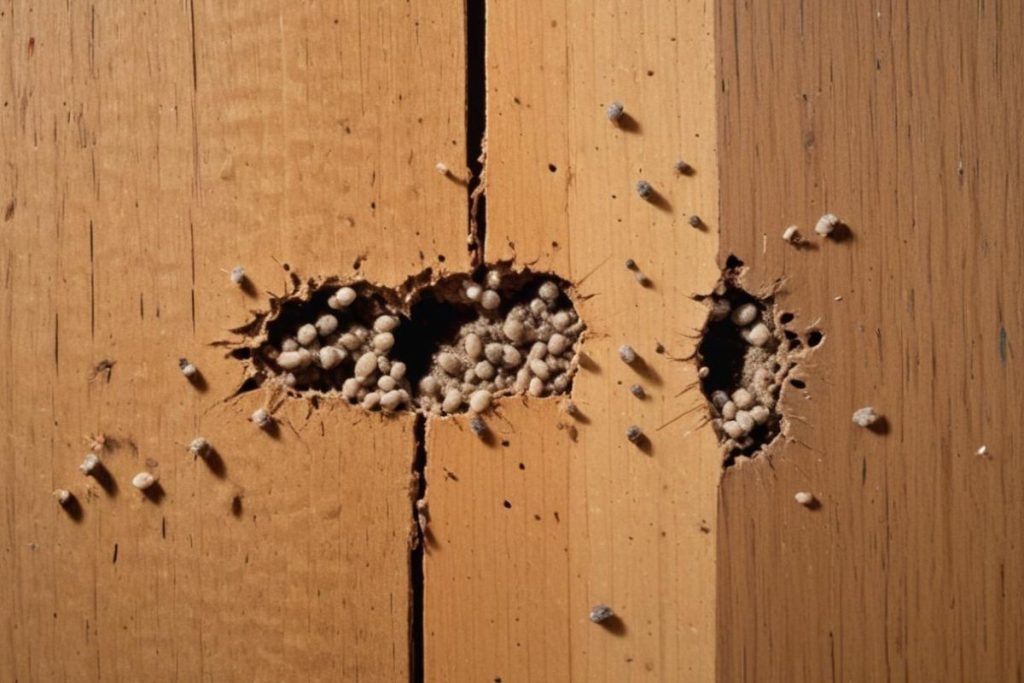The main differences between termite frass and ant frass are their shapes, colors, purpose, and damage intensity. Termite frass has uniform shapes and a coffee-ground color. They do it to consume cellulose from the wood, and the intensity of damage is higher. Ant frass produces coarse debris from excavated wood to create nests. Its color is light brown to yellowish and consists of an ant’s body parts. Since they do not consume the wood, the intensity of damage is lower relative to termite frass.
What is Termite Frass or dropping?
Termite frass is small, dry pellets similar to coffee grounds or finely ground sawdust that termites leave behind. It indicates a termite infestation, and drywood, subterranean, and flying termites are the main culprits of this frass. They digest the wood, and their frass consists of the digested cellulose and soil. You will find this frass near window frames, crawlspaces, wooden baseboards, and areas with untreated or exposed wood in Singapore. You can also find some other signs in those wooden structures, like tiny entry holes, mud tubes, and discarded wings.
What is Ant Frass or dropping?
Ant frass is the waste material that carpenter ants leave during their nest excavation. This frass consists of ant parts, body fragments, sawdust material, and wood debris pushed out through the nest galleries. You will find them near wooden materials, window sills, and entry holes, and often accompanied by ant trails. This frass indicates that carpenter ants are nesting inside the structure and expanding their tunnels.

Key Differences – Ant Frass vs Termite Frass
| Feature | Ant Frass (Carpenter Ants) | Termite Frass (Drywood Termites) |
| Appearance | Irregular, fibrous, messy | Uniform, hard, pellet-like |
| Texture | Coarse with wood splinters and insect parts | Fine, gritty, like coffee grounds |
| Color | Light brown to yellowish, sometimes mixed shades | Tan to dark brown |
| Contents | Wood shavings, insect body parts, food remnants | Digested wood particles, excreted cellulose |
| Origin | Excavated from galleries in wooden structures | Ejected from internal termite tunnels |
| Presence of Insect Parts | Common (legs, wings, dead ants) | Absent (clean pellets) |
| Ejection Method | Kicked out of exit holes near nests | Dropped below infested wood or pinholes |
| Structure Clues | Nest nearby; holes may be visible | Frass often found with mud tubes or pinholes |
| Associated Species | Carpenter ants, flying ants | Drywood termites, flying termites |
| Frass Location | Under baseboards, in corners, near wooden frames | Beneath wooden materials, on windowsills, around door frames |
| Infestation Indicator | Frass is often found with mud tubes or pinholes | Active feeding and hidden infestation |
| Moisture Preference | Damp, decayed wood | Dry, solid hardwood |
| Risk of Structural Damage | Moderate to severe over time | Severe, often extensive, and hidden |
| Common Misidentification | Mistaken for sawdust or general debris | Mistaken for coffee grounds or pepper |
| Treatment Path | Ant control (baits, perimeter sprays) | Termite control (Sentricon®, Soil treatment, professional treatment) |
Differences in Structural Damage and Infestation Insights
Termites and ants damage the wooden structure differently. For example, A large termite colony can even consume 1 pound of wood per day, leading to serious structural damage to your property. Termites consume wood and keep tunnelling for a long time, leaving a space inside the wood. Ants excavate wood for nesting, and they stop doing it once the nesting is complete.
How to Detect & Inspect Ant Frass and Termite Frass
It is ant frass if:
- It is coarse, uneven debris resembling sawdust.
- Contains insect parts or body fragments.
- Found below wooden beams, window sills, or near entry holes.
- Ejected from clean, smooth galleries made by carpenter ants.
- Associated with active ant trails or nearby food sources.
It is termite frass if:
- Looks tiny, dry, pellet-shaped droppings.
- Uniform in size and color, like coffee grounds.
- Found near window frames, baseboards, or drywood furniture.
- Associated with kick-out holes nearby, but no visible insect parts.
- Accompanied by mud tubes, hollow wood, or discarded wings from flying termites.
What actions should you take if you find the frass?
- Do not disturb the frass since disturbing it can scatter the termites and ants, making it difficult to treat.
- Take pictures of them for future reference or expert analysis.
- Inspect the surrounding areas for additional signs like wood damage, ant trails, entry holes, mud tubes, discarded wings, and others.
- Determine the frass type with basic indicators.
- Do not use any inappropriate treatments.
- Contact a licensed professional in Singapore for inspection and treatment.
- Ensure targeted treatment to destroy these insects and their colonies.
When to Call a Pest Technician
If you are in Singapore, call Termite Specialist, a professional pest control company in SG with NEA certification, when you find frass piles, ant trails, mud tubes, and discarded wings associated with wood damage and regular insect activities. We have 13 years of practical experience in Termite eradication. Check our reviews for what people say about us.
FAQ
Q. How to differentiate between an ant and a termite?
A. Ants are darker in color, and they have elbowed antennae, forewings longer than hindwings, and narrow waists. On the other hand, termites are pale or creamy and have straight antennae, wings of equal length, and broad waists.
Q. Is termite frass hard?
Yes, termite frass is relatively hard and dry.
Q. What if I see frass but no termites?
Termite frass is a clear indication of termite infestation, even if you do not see termites. Look for other signs like entry holes, hollow-sounding wood, and noise.
